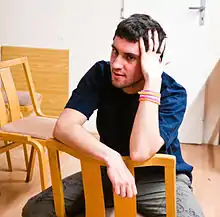Amir Taaki | |
|---|---|
 Taaki in Bratislava, 2012 | |
| Born | 6 February 1988 |
| Nationality | British |
| Occupation | Programmer |
| Military career | |
| Allegiance | Rojava |
| Service/ | YPG |
| Years of service | 2015 |
| Battles/wars | Syrian Civil War |
Amir Taaki (Persian: امیر تاکی; born 6 February 1988) is a British-Iranian anarchist revolutionary, hacktivist, and programmer who is known for his leading role in the bitcoin project, and for pioneering many open source projects.[1][2] Forbes listed Taaki in their 30 Under 30 listing of 2014.[3][4] Driven by the political philosophy of the Rojava revolution, Taaki traveled to Syria, served in the YPG military, and worked in Rojava's civil society on various economic projects for a year and a half.[5]
Biography
Amir Taaki was born 6 February 1988[6] in London, the eldest of three children of a Scottish-English[7] mother and an Iranian father who is a property developer. Taaki grew up in nearby Kent.[8] From an early age Taaki took an interest in computer technology, teaching himself computer programming.[9]
After briefly attending two British universities,[7] Taaki gravitated to the free software movement. Taaki assisted in the creation of SDL Collide, an extension of Simple DirectMedia Layer, an open source library used by video game developers.[10]
In 2009 and 2010, Taaki made his living as a professional poker player.[9] His experience with online gambling attracted him to the Bitcoin project.[11] At one point, he was listed among Bitcoin's main developers.[12] He founded the first UK Bitcoin exchange, "Britcoin", which was succeeded in 2011 by a new British exchange called Intersango, in which he was a principal developer.[13][8] Intersango has since closed.[14]
In 2012, Taaki organized the first Bitcoin conference in London.[15]
In 2014, together with Cody Wilson, he launched the Dark Wallet project after a crowdfunding run on IndieGoGo which raised over $50,000.[16][17][18] Taaki, along with other developers from Airbitz, a bitcoin software company, created a prototype for a decentralised marketplace called "DarkMarket" in 2014, at a hackathon in Toronto, which was forked into the OpenBazaar project.[19]
As of 2013, he resided in an anarchist squat in the former anti-G8 HQ building in London, England.[20][21]
In 2015, Taaki went to Rojava (Syrian Kurdistan) to offer his skills to the revolution and served the YPG military.[22] He had no training but spent three and a half months in the YPG military fighting on the front. He was then discharged and worked in the civil society for over a year on various projects for Rojava's economics committee.
In February 2018, Taaki created a group in Catalonia dedicated to leveraging blockchain technology to help national liberation causes such as the Catalan independence movement.[23]
In 2023, Politico reported that Taaki was working on an anarchist project called DarkFi that aimed to allow people to form organizations that collectively raise and distribute money in complete secrecy.[24]
See also
References
- ↑ Colao, J.J. "Amir Taaki, 25 - In Photos: 2014 30 under 30: Technology". Forbes. Archived from the original on 9 January 2014.
- ↑ Ball, James (20 April 2012). "Hacktivists in the frontline battle for the internet". The Guardian. London. Retrieved 20 April 2012.
- ↑ "Forbes 30 Under 30". Forbes. Retrieved 4 October 2018.
- ↑ "Meet the world's next billionaires - from Mashable's Pete Cashmore to Bitcoin renegade Amir Taaki". The Independent. 7 January 2014. Archived from the original on 7 January 2014.
- ↑ Susannah Butter (6 April 2017). "Tech enigma Amir Taaki on Forbes and fighting Isis in Syria". Standard.co.uk.
- ↑ "Amir Taaki". Companies House. Retrieved 4 October 2018.
- 1 2 Herrmann, Joshi (29 January 2014). "Silicon Roundabout's not for him: meet super-hacker, master coder and Bitcoin boy Amir Taaki in his Hackney squat". Retrieved 30 June 2015.
- 1 2 Bartlett, Jamie (2015). The dark net : inside the digital underworld. Brooklyn. ISBN 978-1-61219-489-9. OCLC 900594552.
{{cite book}}: CS1 maint: location missing publisher (link) - 1 2 "Speakers 2011," 11th International EPCA Summit, European Payments Consulting Association, www.epcaconference.com/ Retrieved 11 October 2011.
- ↑ "SDL_Collide". SourceForge. 8 January 2015. Retrieved 4 October 2018.
- ↑ James Ball, "Bitcoins: how do they work?" The Guardian, 22 June 2011.
- ↑ Herrmann, Joshi (10 July 2015). "The Anarchist Hacker Bitcoin Would Rather Not Talk About". Vice. Retrieved 13 August 2021.
- ↑ "About Us: Personal Statements," Intersango, britcoin.co.uk
- ↑ "Cryptoanarchists pull trigger on fight over future of Bitcoin". Financial Times. 31 October 2013.
- ↑ Healy, Hazel (1 December 2012). "Internet showdown: Why digital freedom matters to us all". New Internationalist. London. Retrieved 16 August 2022.
- ↑ Del Castillo, Michael (24 September 2013). "Dark Wallet: A Radical Way to Bitcoin". The New Yorker. Retrieved 15 May 2014.
- ↑ Greenberg, Andy (31 October 2013). "Dark Wallet Aims To Be The Anarchist's Bitcoin App of Choice". Forbes Online. Retrieved 15 May 2014.
- ↑ Greenberg, Andy (29 April 2014). "'Dark Wallet' Is About to Make Bitcoin Money Laundering Easier Than Ever". Wired. Retrieved 15 May 2014.
- ↑ Greenberg, Andy (24 April 2014). "Inside the 'DarkMarket' Prototype, a Silk Road the FBI Can Never Seize". Wired. Retrieved 23 August 2014.
- ↑ Siddique, Haroon (11 June 2013). "G8: riot police enter central London building occupied by protesters". Retrieved 8 July 2015.
- ↑ Copestake, Jen (19 September 2014). "Hiding currency in the Dark Wallet". Retrieved 8 July 2015.
- ↑ Greenberg, Andy (29 March 2017). "How an anarchist Bitcoin coder found himself fighting ISIS in Syria". Wired. Retrieved 4 October 2018.
- ↑ Volpicelli, Gian (6 March 2018). "Amir fought Isis in Syria, now he's enlisting an army of hacker monks to save bitcoin from itself". wired. Retrieved 3 October 2018.
- ↑ Schreckinger, Ben (February 2, 2023) "A new crypto threat to government launches." Politico. (Retrieved March 6, 2023).